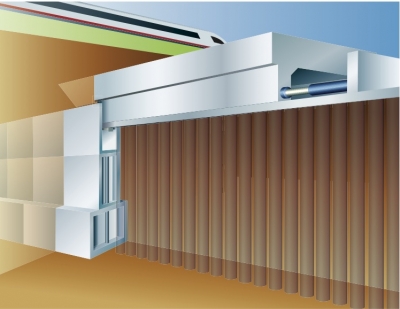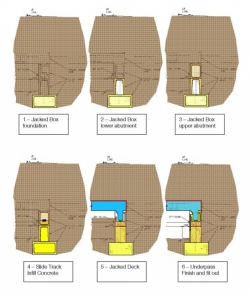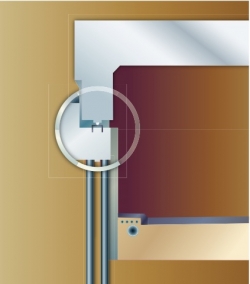The Jacked Deck
The basic concept of this patented method is to provide a deck or roof on top of a support structure by jacking horizontally and with minimal surface disturbance either a cast in-situ slab or series of individual pre-cast beams to form the deck/roof.
Such a system is used in relatively shallow applications such as underpasses where it is important not to disrupt surface traffic or surface structures. It also can be used in deep underground construction such as metro stations where because of depth it is more economic to install the structure using horizontal jacking methods to create the structure envelope ahead of the excavation of the earth thus avoiding deep expensive and disruptive excavations.
The Jacked Deck
This approach allows the whole of the underground structure – foundations, walls and deck/roof - to be installed without surface disruption.
Typically the depth of a deck or a beam to span 10 metres or greater will have a depth of 1.5 metres and upwards. A temporary shield is attached to the front of the deck with access provided for men and machines to excavate. The depth of the face working area is not an issue in that it can be made deeper as the excavation area is contained within the previously driven walls.
The key features are
- The deck can be formed from an in-situ RC slab or a series of pre-cast beams
- At the front face a shield is fixed where the excavation is carried out
- The shield is compartmentalized to allow control of the face
- The face depth is much less than in a jacked box and easier to control
- The depth of working area in the shield can be increased by excavating below the soffit of the deck as work is safely contained within the previously installed walls.
- As the deck is jacked forward lids on the top wall boxes are removed to expose the slide channel which also acts as the permanent bearing
- The deck is jacked in along this path
- Greater lengths of drive are possible
- Clear spans of 20m or greater are possible
- The friction between soil and top of deck can be reduced to low values by use of tried and tested methods of drag minimization methods.
- The jacking loads at all stages of installation are relatively small as the individual size of units offers only a small frictional surface
Installing the foundations and abutments
There are various approaches to creating foundations and (walls) abutments which provide the guide/bearing track on which the deck is installed.
Approach Based on Modular Jacking
The concept of creating a support or foundation structure using interlinked pre-cast components which are jacked into position horizontally is described in a previous section
When part of the Jacked Deck concept there is some amendment to the detail. In the upper section of the wall box a guide/ bearing track is constructed very precisely which will be the path along which the jacked deck will slide as it is jacked forward. The upper part of the box is designed so that a section can be removed as the deck advances to expose this track.
Jacked Structures are currently providing technical services to a contract in UK for a 120m long by 20m wide underpass below rail tracks, based on the Jacked Deck concept.
Approach based on Access Gallery
An alternative approach is to create an access gallery using jacked tubes or boxes with dimensions that allow piled abutment walls and foundations to be created . After completion of the piling the guide bearing track can be installed to precise line and level. The access tubes or boxes used to form the gallery are designed to allow sections to be removed to expose the track as the deck is jacked into place.
Virtually any form of underground structure can be created by using differing configurations of modular units, galleries and jacked decks
These can range from underpasses with spans normally with a 10m span or greater. By use of more than one span and a central pier it is possible to create separate carriageways. The individual spans are limited only by the practicalities of the deck design and can easily exceed 20m.
For large underground structures at depth such as metro stations, car parking or caverns it is possible from relatively small access excavations to create a structural shell which allows the majority of work to be undertaken inside the shell safely and without surface disruption.
Installing Directly Below the Tracks
It is possible to jack the deck in immediately below the rail tracks as has been done with Jacked Boxes. The proven method allows transfer of the load from track and trains directly onto the top of the deck and not through any soil cover.
This is done by constructing a load spreading support grid immediately below the track. This consists of structural sections constructed parallel to the track and cross connections across the width of the tracks. The longitudinal members parallel to the sleepers and at the same level, the cross members below the longitudinal members. All installed in short possessions.
As the deck advances by use of hydraulic projecting “spiles” from the shield designed to make contact with the cross members and pick up the track load in advance of the deck and that effective load transfer takes place. In order to ensure that no horizontal force is induced in the support system two methods have been successfully used.
1. By use of industrial skates between the top of the box and the cross beams
2. By use of Teflon faces on the deck and cross beams with suitable lubricants
Once the deck is installed the rail track load is carried directly by the deck.
East Kent Access
One of the largest jacked structures ever installed was completed in 2012 at Cliffsend, Kent. This 126m long and 20m clear span underpass was driven under operational rail tracks using the jacked deck concept.
A time elapsed video produced by Hochtief the main contractor illustrates the installation and can be viewed at




